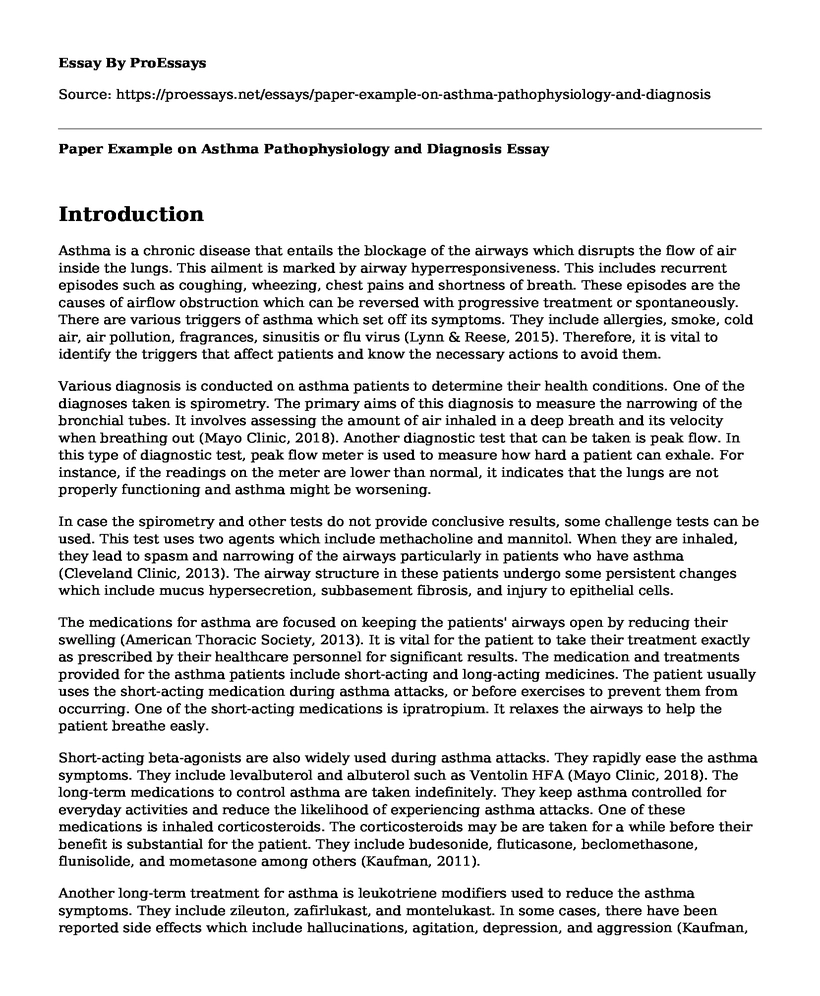Introduction
Asthma is a chronic disease that entails the blockage of the airways which disrupts the flow of air inside the lungs. This ailment is marked by airway hyperresponsiveness. This includes recurrent episodes such as coughing, wheezing, chest pains and shortness of breath. These episodes are the causes of airflow obstruction which can be reversed with progressive treatment or spontaneously. There are various triggers of asthma which set off its symptoms. They include allergies, smoke, cold air, air pollution, fragrances, sinusitis or flu virus (Lynn & Reese, 2015). Therefore, it is vital to identify the triggers that affect patients and know the necessary actions to avoid them.
Various diagnosis is conducted on asthma patients to determine their health conditions. One of the diagnoses taken is spirometry. The primary aims of this diagnosis to measure the narrowing of the bronchial tubes. It involves assessing the amount of air inhaled in a deep breath and its velocity when breathing out (Mayo Clinic, 2018). Another diagnostic test that can be taken is peak flow. In this type of diagnostic test, peak flow meter is used to measure how hard a patient can exhale. For instance, if the readings on the meter are lower than normal, it indicates that the lungs are not properly functioning and asthma might be worsening.
In case the spirometry and other tests do not provide conclusive results, some challenge tests can be used. This test uses two agents which include methacholine and mannitol. When they are inhaled, they lead to spasm and narrowing of the airways particularly in patients who have asthma (Cleveland Clinic, 2013). The airway structure in these patients undergo some persistent changes which include mucus hypersecretion, subbasement fibrosis, and injury to epithelial cells.
The medications for asthma are focused on keeping the patients' airways open by reducing their swelling (American Thoracic Society, 2013). It is vital for the patient to take their treatment exactly as prescribed by their healthcare personnel for significant results. The medication and treatments provided for the asthma patients include short-acting and long-acting medicines. The patient usually uses the short-acting medication during asthma attacks, or before exercises to prevent them from occurring. One of the short-acting medications is ipratropium. It relaxes the airways to help the patient breathe easly.
Short-acting beta-agonists are also widely used during asthma attacks. They rapidly ease the asthma symptoms. They include levalbuterol and albuterol such as Ventolin HFA (Mayo Clinic, 2018). The long-term medications to control asthma are taken indefinitely. They keep asthma controlled for everyday activities and reduce the likelihood of experiencing asthma attacks. One of these medications is inhaled corticosteroids. The corticosteroids may be are taken for a while before their benefit is substantial for the patient. They include budesonide, fluticasone, beclomethasone, flunisolide, and mometasone among others (Kaufman, 2011).
Another long-term treatment for asthma is leukotriene modifiers used to reduce the asthma symptoms. They include zileuton, zafirlukast, and montelukast. In some cases, there have been reported side effects which include hallucinations, agitation, depression, and aggression (Kaufman, 2011). Other alternative treatments have also been used in asthma treatment which does not involve clinical medications. For instance, breathing exercises by patients are used to reduce the medications taken to manage asthma symptoms. They are usually recommended for patients experiencing adverse side effects of the prescribed drugs. Herbal and natural remedies have also been used to treat asthma. Some of them include caffeine, pycnogenol, and choline (Mayo Clinic, 2018).
References
American Thoracis Society (2013). 'What is Asthma?' ATS Patient Education Series.
Lynn, S.J. & Reese, K.K. (2015). 'Understanding asthma pathophysiology, diagnosis, and management.' Retrieved June 28, 2018 from https://www.americannursetoday.com/understanding-asthma-pathophysiology/Kaufman, G. (2011). Asthma: pathophysiology, diagnosis and management. Nursing Standard (through 2013), 26(5), 48.
Cleveland Clinic (2013). 'Asthma: Testing & Diagnosis: Test Details.' Retrieved June 28, 2018 from https://my.clevelandclinic.org/health/diagnostics/8958-asthma-testing--diagnosis/test-details
Mayo Clinic (2018). 'Asthma.' Retrieved June 28, 2018 from https://www.mayoclinic.org/diseases-conditions/asthma/symptoms-causes/syc-20369653
Cite this page
Paper Example on Asthma Pathophysiology and Diagnosis. (2022, Jun 23). Retrieved from https://proessays.net/essays/paper-example-on-asthma-pathophysiology-and-diagnosis
If you are the original author of this essay and no longer wish to have it published on the ProEssays website, please click below to request its removal:
- Mosquito-Borne Diseases
- Nursing Philosophy Paper Example
- Assessment of Population Needs, Assets and Capacities Affecting Communities' Health
- Essay Sample on Pro-Choice Abortion
- Essay Sample on Advancement in Electronic Health Records - Feminist lens
- Essay Example on Biological Factors in Human Behavior: COVID-19 Impact
- Essay Example on Language Barrier Overcome: My Most Notable Nursing Experience







